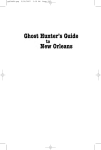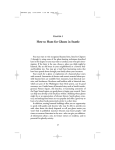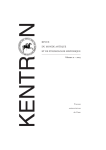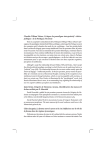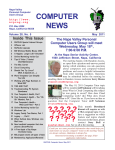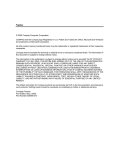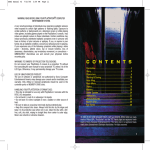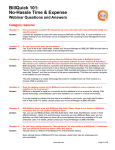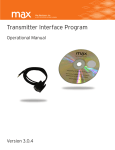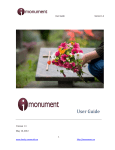Download How to Hunt for Ghosts - Pelican Publishing Company
Transcript
gh06e01.qxp 8/21/2008 2:46 PM Page 29 CHAPTER 1 How to Hunt for Ghosts You may want to visit recognized haunted sites, listed in chapters 2 through 6, using some of the ghost hunting techniques described later in this chapter. Or you may want to conduct your own spirit investigation. If that is the case, choose a place you think might be haunted, like an old house in your neighborhood or a favorite bedand-breakfast inn. You may get a lead from fascinating stories about ancestors that have been passed down through your family. Your search for a ghost, or exploration of a haunted place, starts with research. Summaries of obscure and esoteric material about possible haunted sites are available from museums, local historical societies, and bookstores. Brochures and booklets, sold at historical sites under the California State Park system, can be good resources, too. Guided tours of historical sites such as Sonoma’s Plaza, the old neighborhood in Healdsburg, Railroad Square in Santa Rosa, or old churches, wineries, and pioneer cemeteries throughout the Wine Country are good places to begin your research. Tours can help you develop a feel for places within a building where ghosts might be sighted or an appreciation of relevant history. Wine Country ghost, cemetery, and history tours are very popular and offer a good way to learn a lot about local paranormal activity in a short time. In addition, touring haunted buildings offers you an opportunity to speak with guides and docents who may be able to provide you with clues about the dearly departed or tell you ghost stories you can’t find in published material. Docents may know people—old-timers in the area or amateur historians—who can give you additional information about a site, its former owners or residents, and its potential for ghostly activity. 29 gh06e01.qxp 8/21/2008 2:46 PM Page 30 30 D GHOST HUNTER’S GUIDE TO CALIFORNIA’S WINE COUNTRY Almost every city has a local historical society (see Appendix G). These are good places to find information that may not be published anywhere else. This could be histories of local families and buildings; information about tragedies, disasters, criminal activity, or legends; and myths about places that may be haunted. You will want to take notes about secret scandals or other ghost-producing happenings that occurred at locations now occupied by modern buildings, roads, or parks. In these cases, someone occupying a new house or other structure could hear strange sounds, feel cold spots, or see ghosts or spirit remnants. Newspapers are an excellent source of historical information, as well. You can search for articles about ghosts, haunted places, or paranormal activity by accessing the newspaper’s archives via the Internet and entering key words, dates, or names. Newspaper articles about suicides, murders, train wrecks, plane crashes, and paranormal phenomena can often provide essential information for your ghost hunt. Stories about authentic haunted sites are common around Halloween. Bookstores and libraries usually have special-interest sections with books on local history by local writers. A few inquiries may connect you with these local writers who may be able to help you focus your research. If these living souls cannot help, try the dead. A visit to a local graveyard is always fruitful in identifying possible ghosts. Often you can find headstones that indicate the person entombed died of suicide, criminal activity, local disaster, or such. Some epitaphs may indicate if the deceased was survived by a spouse and children, or died far from home. Perhaps the best place to start a search for a ghost is within your own family. Oral histories can spark your interest in a particular ancestor, scandal, building, or site relevant to your family. Old photographs, death certificates, letters and wills, anniversary lists in family Bibles, and keepsakes can be great clues. Then you can visit gravesites or homes of your ancestors to check out the vibes as you mentally and emotionally empathize with specific aspects of your family’s history. Almost every family has a departed member who died at an early gh06e01.qxp 8/21/2008 2:46 PM Page 31 How to Hunt for Ghosts d 31 age, suffered hardships and emotional anguish, passed away suddenly due to an accident or natural disaster, or was labeled a skeleton in the family’s closet. Once you have focused your research on a deceased person, you need to determine if that person remains on this earthly plane as a ghost. Evaluate the individual’s personal history to see if he had a reason to remain attached to a specific place. Was his death violent or under tragic circumstances? Did he die at a young age with unfinished business? Did the deceased leave behind loved ones who needed his support and protection? Was this person attached to a specific site or building? Would the individual be inclined to seek revenge against those responsible for his death? Would his devotion and sense of loyalty lead him to offer eternal companionship to loved ones? Revenge, anger, refusal to recognize the reality of transformation by death, and other negative factors prompt many spirits to haunt places and people. However, most ghosts are motivated by positive factors. Spirits may remain at a site to offer protection to a loved one or a particular place. Also, remember that ghosts can appear as animals or objects. Apparitions of ships, buildings, covered wagons, bridges, and roads by the strictest definitions are phantoms. A phantom is the essence of a structure that no longer exists on the physical plane. Many people have seen houses, cottages, castles, villages, and large ships that were destroyed or sunk years before. BASIC PREPARATION FOR GHOST HUNTING If you decide to ghost hunt at night or on a special anniversary, make a trip to the site a few days ahead of time. During daylight hours, familiarize yourself with the place and its surroundings. Many historical sites are closed after sunset or crowded at certain times by organized tours. gh06e01.qxp 8/21/2008 2:46 PM Page 32 32 D GHOST HUNTER’S GUIDE TO CALIFORNIA’S WINE COUNTRY TWO BASIC METHODS FOR FINDING GHOSTS Based partly on the kind of paranormal activity reported at a site, the ghost hunter must decide which method or approach will be used. Some will feel competent with a collection of cameras, electromagnetic field detectors, digital thermometers, computers, data recorders, and other high-tech gadgets. These ghost hunters prefer to use the Technical Approach. Others may discover they have an emotional affinity for a particular historic site, a surprising fascination with an event associated with a haunting, or empathy for a deceased person. These ghost hunters may have success with the Psychic Approach. Another consideration is the ghost hunter’s goal. Some desire scientific evidence of a ghost while others simply want to experience paranormal activity. THE TECHNICAL APPROACH Professional ghost hunters often use an array of detection and recording devices that cover a wide range of the electromagnetic spectrum. This approach is complicated, expensive, and requires technically skilled people to operate the devices. Amateur ghost hunters can get satisfying results with simple audio and video recording devices. Equipment Preparation A few days before your ghost hunt, purchase fresh film for your camera and tape for audio recording devices. Test your batteries and bring backup batteries and power packs with you. You should have two types of flashlights: a broad-beam light for moving around a site and a penlight-type flashlight for narrow-field illumination while you make notes or adjust equipment. A candle is a good way to light the site in a way that is least offensive to a ghost. Still-Photography Techniques Many film-based photographic techniques that work well under normal conditions are inadequate for ghost hunts. That’s because ghost hunting is usually conducted under conditions of low ambient light. This requires the use of long exposures or film with greater light gh06e01.qxp 8/21/2008 2:46 PM Page 33 How to Hunt for Ghosts d 33 sensitivity (ASA). Some investigators use a strobe or flash device, but these can make the photos look unauthentic or create artifacts. If you use film-based photography, practice taking photos with films of various light sensitivities before you go on your ghost hunt. Standard photographic films of high light sensitivity should be used—ASA of 800 or higher is recommended. At a dark or nearly dark location, mount the camera on a tripod. Try several exposure settings, from one to 30 seconds, and aperture settings under various low-light conditions. Make notes about the camera settings that work best under various light conditions. Avoid aiming the camera at a scene where there is a bright light such as a street lamp or exit sign over a doorway. These light sources may “overflow” throughout your photograph. Some professional ghost hunters use infrared film. You should consult a professional photo lab technician about this type of film and its associated photographic techniques. Amateur ghost hunters have used Polaroid-type cameras with interesting results. The rapid film developing system used by these cameras gives almost instant feedback about your technique and/or success in documenting ghost activities. Ghosts have reportedly written messages on Polaroid film. If you plan to use digital photographic methods, practice taking pictures under conditions of low ambient light, with and without artificial lighting. Most digital cameras have default automatic settings that might not work well during a ghost hunt. These settings may not be easily changed as ambient conditions change unless you have practiced the procedures. Many of these cameras have features that enable automatic exposures at specific intervals, e.g., once every minute. This allows a hands-off remote photograph record to be made. Repetitive automatic exposures also allow a site to be investigated without the presence of the investigator. Be aware that many digital cameras produce light anomalies called orbs. While some ghost hunters believe orbs are manifestations of spirit energy, professional paranormal investigators argue that they are artifacts created by various technical characteristics of the camera and flash unit. You may avoid flash-induced artifacts by disabling the light source or using a light source that is more that two feet from the camera’s lens. gh06e01.qxp 8/21/2008 2:46 PM Page 34 34 D GHOST HUNTER’S GUIDE TO CALIFORNIA’S WINE COUNTRY Your equipment should include a stable, lightweight tripod. Hand-held cameras may produce poorly focused photographs when the exposure duration is greater than 1/60 second. Audio Recording Techniques Audio recorders provide an inexpensive way to obtain evidence of ghostly activity, particularly electronic voice phenomenon or EVP. This is an audio recording of spoken words or any other sound, such as sobbing, crying, whistling, growling, tapping, or screaming, for which there is no normal explanation. The recording often includes the ghost hunter asking questions or inviting a spirit to make a sound. Typically, the ghost hunter does not hear a reply, but it is discovered later while replaying the recording. It is wise to test your recorder under conditions you expect to find at the investigation site in order to reduce audio artifact and ensure optimal performance of the device. Does your recorder pick up excessive background noise? This may obscure ghostly sounds. If so, consider upgrading the tape quality and using a microphone equipped with a wind guard. Use two or more recorders at different locations within the site. This allows you to verify sounds, such as wind against a window, and reduce the possibility of ambiguous recordings. You can use sound-activated recorders at a site overnight. They will automatically switch on whenever a sound occurs above a minimum threshold. Be aware that each sound on the tape will start with an annoying artifact, the result of a slow tape speed at the beginning of each recorded segment. The slow tape speed could obscure the sounds made by a ghost. Remote microphones and monitor earphones allow you to remain some distance from the site and activate the recorder when ghostly sounds are heard. If this equipment is not available, use long-play tape (60-90 minutes), turn the recorder on, and let it run throughout your hunt, whether you remain stationary or walk about the site. This will provide you with a means of making audio notes rather than written notes. A headset with a microphone is especially useful with this technique. Digital audio recorders are much smaller than tape-based recording gh06e01.qxp 8/21/2008 2:46 PM Page 35 How to Hunt for Ghosts d 35 systems and offer the advantage of interfacing with your computer. This allows you to edit your recordings, make comparisons between recordings, and archive your EVP. Video Recording Video recorders offer a wide variety of recording features from time-lapse to auto-start/stop, and auto focus. These features enable you to make surveillance-type recordings over many hours while you are off-site. Consult your user’s manual for low-light recording guidelines, and always use a tripod and long-duration battery packs. If you plan to attempt video recording, consider using two recorders, at equal distance from a specific object such as a chair. Arrange the recorders at different angles, preferably 90 degrees from each other. Another approach you might try is to use a wide-angle setting on the first camera to get a broad view of a room, porch, or courtyard. On the second camera, use a close-up setting to capture ghostly apparitions at a door, chair, or window. You may have more success with sequential, manual, or timeractuated tape runs than a continuous-record technique. If you try this technique, use tape runs of one to five minutes. Practice using the method that interrupts the automatic setting should you need to manually control the recording process. Always use a tripod that can be moved to a new location in a hurry. High-Tech Equipment Night vision goggles can be useful in low-light situations. You can see doors and other objects move that you might not otherwise see. These goggles are quite expensive, however. You can buy devices such as electromagnetic field detectors, infrared thermometers, barometers, and motion detectors at your local electronics store or over the Internet. A good source for high-tech ghost hunting equipment is www.technica.com. Electronic gadgets can be useful and fun, but unless you have a means of recording the output, your reports of anomalies, movement, and apparitions will not be the kind of hard evidence you need to satisfy skeptics. gh06e01.qxp 8/21/2008 2:46 PM Page 36 36 D GHOST HUNTER’S GUIDE TO CALIFORNIA’S WINE COUNTRY Other Equipment Various authorities in the field of ghost hunting suggest the following basic items to help you mark sites, detect paranormal phenomena, and collect evidence of ghostly activity. White and colored chalk Compass Stop watch Steel tape measure Magnifying glass Two stacks of ten pennies Thermometer Metal detector Graph paper for diagrams Small mirror Small bell Plastic bags for collecting evidence Matches Tape for sealing doors String A cross A Bible Cell phone Candles Flashlights THE PSYCHIC APPROACH The Psychic Approach relies upon your intuition, inner vision, or emotional connection with a deceased person, object, place, or point of time in history. You don’t have to be a trained psychic to use this approach. All of us have some capacity to tap into unseen dimensions. People who feel the peculiar atmosphere of a distant time, or who believe they can perceive a voice, sound, image, touch, or texture of another dimension may have psychic abilities that will pay off in a ghost hunt. The Psychic Approach does require an ability to eliminate external and internal distractions and focus your perceptions. If you use this approach, three factors may increase your chances of experiencing ghostly activity. gh06e01.qxp 8/21/2008 2:46 PM Page 37 How to Hunt for Ghosts d 37 The first factor is the strength of the emotional imprint or attachment of the deceased for a particular place. The frequency, duration, and consistency of the paranormal phenomena may indicate the strength of the imprint. The strongest imprints are created by intense emotions, such as fear, rage, jealously, revenge, or loss, especially if they were repetitive over long periods of time prior to death. Other emotions such as love for a person, a place, or an object may also create a strong imprint. Biographical research may reveal this kind of information, particularly if personal letters or diaries are examined. Old newspaper articles and photographs are useful too. The second factor is the degree of sensitivity the investigator has for environmental imprints. Knowledge of the key elements and historical context of the entity’s death can increase your sensitivity. This includes architectural elements of a home, theatre, airplane or ship, furniture, clothing, weapons, or any implement or artifact of the specific time period. Touching or handling these artifacts, or standing within the historic site, enables ghost hunters to get in touch with the historical moment of the ghost’s imprint. A high degree of sensitivity for a past era often generates an odd feeling of being transported through time. The third factor is sensitivity to or empathy for the ghost’s lingering presence at a haunted site. A ghost may be trapped, confused, or have chosen to remain at a site to protect someone or guard something precious. Sensitivity for the ghost’s predicament can be increased through knowledge of the entity’s personal history, such as emotions, motivations, problems, or unfinished business at the time of death. Researching historical sources like newspapers, old photographs, or books can provide this kind of information. Useful, intimate details might be found in letters, suicide notes, diaries, and wills. Your sensitivity to ghostly environmental imprints and spirit manifestations may be increased by meditation. This is a simple process of relaxing one’s physical body to eliminate distracting thoughts and tensions and achieve emotional focus. Meditation allows you to focus your spiritual awareness on a single subject—a place, entity, or historic moment in time. As the subject comes into focus, you can add information obtained from your research. Markers of time or seasons, artifacts or implements, furniture, and doorways are a few suggestions. By gh06e01.qxp 8/21/2008 2:46 PM Page 38 38 D GHOST HUNTER’S GUIDE TO CALIFORNIA’S WINE COUNTRY doing this, you become aware of unseen dimensions of the world around you that create a feeling that you have moved through time to a distant era. This process gets you in touch with the place, date, and time pertinent to a ghost’s imprint or death. The process also enables you to disregard personal concerns and distracting thoughts that may interfere with your concentration on the ghost you seek. Keep in mind that it is possible to be in a meditative state while appearing quite normal. The process is simple and easy to learn. When you arrive at the site of your ghost hunt, find a place a short distance away to meditate. Three essentials for any effective meditation are comfort, quiet and concentration. Comfort: Sit or stand in a relaxed position. Take free and even breaths at a slow rate. Do not alter your breathing pattern so much that you feel short of breath, winded, or lightheaded. Close your eyes if that enhances your comfort, or focus on a candle, a tree, or a flower. Do not fall asleep. Proper meditation creates relaxation without decreasing alertness. Quiet: Meditate in a place away from noises generated by traffic, passersby, radios, slammed doors, and the like. If you are with a group, give each other sufficient personal space. Some people use mantras, repetitive words or phrases, or speak only in their mind in order to facilitate inner calmness. Mantras are useful to induce a focused state of relaxation, but they may disrupt the meditation of a companion if spoken aloud. A majority of ghost hunters do not believe that mantras are necessary in this instance. They point out that ghost hunting is not like a séance as depicted in old movies. It is not necessary to chant special words, call out to the dead, or invite an appearance “from beyond the grave.” Concentration: First, clear your mind of everyday thoughts, worries, and concerns. This is the most difficult part of the process. Many of us don’t want to let go of our stressful thoughts. To help you let go of those thoughts, let the thought turn off its light and fade into darkness. After you clear your mind, some thoughts may reappear. Repeat the process. Slowly turn off the light of each thought until you can rest with a completely cleared mind. This might take some practice. Don’t wait until you are on the scene of a ghost hunt before you practice this exercise. gh06e01.qxp 8/21/2008 2:46 PM Page 39 How to Hunt for Ghosts d 39 Once your mind is clear, focus on your breathing and imagine your entire being as a single point of energy driving the breathing process. Then, open yourself. Think only of the entity you seek. Starting with the ghost’s identity (if known), slowly expand your focus to include its personal history, the historical era of the ghost’s death or creation of the emotional imprint, the reported nature and appearance of the haunting, and any specific ghostly activity. Acknowledge each thought as you continue relaxed breathing. Find a thought that is most attractive to you, and then expand your mind to include your present surroundings. Return slowly to your current place and time. Remain quiet for a minute or two before you resume communication with your companions, then move ahead with the ghost hunt. GROUP ORGANIZATION AND PREPARATION It is not necessary to believe in spirits or paranormal phenomena in order to see a ghost or experience haunting activities. Indeed, most reports of ghost activities are made by unsuspecting people who never gave the matter much thought. But you should not include people in your group with openly negative attitudes about these things. If you include skeptics, be sure they maintain an open mind and are willing to participate in a positive group attitude. Keep your group small, limited to four members if possible. Ghosts have been seen by large groups of people, but small groups are more easily managed and likely to be of one mind in terms of objectives and methods. Meet an hour or more prior to starting the ghost hunt at a location away from the site. Review the history of the ghost you seek and the previous reports of ghost activity at the site. Discuss the group’s expectations based on known or suspected ghostly activity or specific research goals. Review possible audio and visual apparitions based on the history of paranormal activity at the site, telekinesis, local temperature changes, and intended methods of identifying or recording these phenomena. Most important, agree to a plan of action if a sighting is made by any member of the group. The first priority for a ghost hunter is to maintain visual or auditory gh06e01.qxp 8/21/2008 2:46 PM Page 40 40 D GHOST HUNTER’S GUIDE TO CALIFORNIA’S WINE COUNTRY contact without a lot of activity such as making notes. Without breaking contact, do the following: activate recording devices redirect audio, video, or photographic equipment to focus on the ghost move yourself to the most advantageous position for listening or viewing the ghostly activity attract the attention of group members with a code word, hand signal (for example, touch the top of your head), or any action that signals other hunters so they can pick up your focus of attention Should you attempt to interact with the ghost? Do so only if the ghost invites you to speak or move. Often, a ghost hunter’s movement or noise frightens the ghost or interferes with the perception of the apparition. SEARCHING FOR GHOSTS There are no strict rules or guidelines for successful ghost hunting except BE PATIENT! Professional ghost hunters sometimes wait several days, weeks, or even months before achieving contact with a ghost. Others have observed full-body apparitions when they least expected it, while concentrating fully on some other activity. Regardless of the depth of your research or preparation, you need to be patient. The serious ghost hunter will anticipate that several trips to a haunted site may be required before some sign of ghostly activity is observed. If you hunt with a group, you need to establish a communications system in the event that even one member sights a ghost or experiences some evidence of ghostly activity. Of course, confirmation by a second person is important in establishing validity and credibility. In the previous section, a hand signal (hand to the top of the head) was recommended as a means of informing others that they should direct their eyes and ears to a site indicated by the person in contact with a ghost. Because of this, all ghost hunters need to keep their companions in sight at all times and be aware of hand signals. An audio signal can often reduce the need for monitoring other gh06e01.qxp 8/21/2008 2:46 PM Page 41 How to Hunt for Ghosts d 41 ghost hunters for hand signals. Equally important for a group is to establish a method for calling other hunters who may be some distance away. Tugging on a length of string can be an effective signal. So can beeping devices, mechanical “crickets,” and flashing penlight signals, i.e., one flash for a cold spot and two flashes for an apparition. Hand-held radios, or walkie-talkies, can also be effective. Some models can send an audio signal or activate flashing lights. Cell phones can be used, but the electromagnetic activity may be uninviting to your ghost. Remaining stationary within a room, gravesite, courtyard, or other confirmed location is often most productive. If a ghost is known to have a favorite chair, bed, or other place within a room, he will appear. Under these conditions, the patient ghost hunter will have a successful hunt. If your ghost is not known to appear at a specific place within a room or an outdoor area, position yourself to gain the broadest view of the site. A corner of a room is optimal because it allows the ghost unobstructed motion about the place while avoiding the impression of a trap set by uninvited people who occupy his favorite space. If you are outdoors at a gravesite, for instance, position yourself at the base of a tree or in the shadows of a monument to conceal your presence while affording a view of your ghost’s grave. If your ghost is a mobile spirit, moving throughout a house, over a bridge, or about a courtyard or graveyard, you may have no choice but to move around the area. Search for a place where you feel a change in the thickness of the air or a cold spot or detect a peculiar odor. If you are ghost hunting with others, it may be advantageous to station members of your group at various places in the ghost’s haunting grounds and use a reliable system to alert others to spirit activity. Each member could then patrol a portion of the site. Radio or cell phone communications may be essential for this type of ghost hunt. Once you are on site, the above-described meditation may help you focus and maintain empathy for your ghost. Investigate sounds, even common sounds, as the ghost attempts to communicate with you. Make mental notes of the room temperature, air movement, and the sensations of abrupt change in atmosphere as you move about the site. Changes in these factors may indicate the presence of a ghost. gh06e01.qxp 8/21/2008 2:46 PM Page 42 42 D GHOST HUNTER’S GUIDE TO CALIFORNIA’S WINE COUNTRY Pay attention to your own sensations or perceptions, such as the odd feeling that someone is watching you, standing close by, or touching you. Your ghost may be hunting you! WHAT TO DO WITH A GHOST On occasion, professional ghost hunters make contact with a ghost by entering a trance and establishing two-way communications. The ghost hunter’s companions hear him or her speak but the ghost’s voice can only be heard by the trance communicator. Sylvia Browne’s book Adventures of a Psychic describes several of these trance communication sessions. Most ghost encounters are brief with little opportunity to engage the entity in conversation. But the ghost may make gestures or acknowledge your presence through eye contact, a touch on the shoulder, sound, or a movement of an object. The ghost hunter must decide whether or not to follow the gestures or direction of a ghost. Visitors to the region’s older wineries and historic buildings often feel the touch or tug of a ghost on their arm or shoulder. Spirits of deceased workers known as cellar rats, winemakers, or grape farmers may be trying to get living souls to notice them, move out of their way, or follow them to some important destination. A ghost at Calistoga’s Pioneer Cemetery, believed to be a veteran of the Civil War, points to the location of his grave. Many who have seen this ragged fellow wonder if he is trying to get someone to open his coffin to retrieve valuables. This ghost and others who wander the cemetery close to Foothill Boulevard sometimes wave to people driving by, beckoning them to follow. Phantom hitchhikers have been spotted on Oakville Crossroads and Yountville Road in the Napa Valley, and alongside Highway 128 in the Anderson Valley. Those who offered a ride to lifelike spirits were shaken when they disappeared from the passenger’s seat, but they suffered no ill effects. In Sonoma and Geyserville, the ghosts of Indian chiefs and shamans have appeared in several locations, including private homes, parks, vineyards, and inns. The menacing appearance of these tall spirits—sometimes dressed in colorful robes—has left some observers gh06e01.qxp 8/21/2008 2:46 PM Page 43 How to Hunt for Ghosts d 43 stunned and others scared out of their wits, but there are no reports of physical or psychological injury. At the restored Uptown Theatre in Napa, a male ghost named Charles creates an unpleasant atmosphere and dislikes sharing his favorite spaces with the living. When alive, Charles was a regular at the theatre. After becoming well known to the staff, he was allowed to wander the premises, including the projection booth, in spite of his odd behavior. Charles was known to urinate in his seat, be rude to other patrons, and complain loudly if someone blocked his view of the screen. In the mid-1950s, crotchety old Charles died of a heart attack while watching a movie. Today, he roams the restored theatre, creating a cold, unfriendly atmosphere for anyone in his way. Sometimes, he grabs or pushes people, slams doors, or creates the odor of urine if a patron dares to occupy his favorite seat. To date, there are no credible or confirmed reports of lasting ill effects by those who have been brave enough to follow these spirits or have experienced contact with them. Experiences such as this are frightening to most of us. More often, the ghost’s activities are directed at getting the intruder to leave a room, house, or gravesite. If you sense your ghost wants you to leave, most hunters believe it is best not to push your luck. When you have established the nature of the ghost activity, ascertained that your companions have experienced the activity, taken a few photographs, and run a few minutes of audio tape, it may be time to leave. An experience with an unfriendly ghost can be disturbing. Residents of haunted houses and employees of haunted business establishments often accept a ghost’s telekinetic or audio activities without concern. It is part of the charm of a place and may add some fun to working in a spooky building. AFTER THE GHOST HUNT Turn off all recorders and remove them to a safe place. Some ghost hunters suspect that ghosts can erase tapes. Label your tapes with the date, time, and location. Use a code number for each tape. Keep a separate record of where the tape was made, date, time, and contents. Place tapes in a waterproof bag with your name, address, telephone gh06e01.qxp 8/21/2008 2:46 PM Page 44 44 D GHOST HUNTER’S GUIDE TO CALIFORNIA’S WINE COUNTRY number, and a note that guarantees postage in case it is misplaced. Have photographic film developed at a professional color laboratory. Pros at the lab may help you with cropping and image enhancement. Have copies made of the negatives that contain ghostly images. All members of the group should meet right after the hunt, away from the site. Each hunter who witnessed ghostly activity or apparition should make a written or audio statement describing the experience. The form presented in Appendix A is for the group leader to complete. Video and audio recordings made at the site should be reviewed and reconciled with witness statements. Then, plans should be made for a follow-up visit in the near future to the site to confirm the apparition, its nature and form, and the impressions of the initial ghost hunt. Data about the ghost’s location within a site may indicate the optimal conditions for future contact. Things to be aware of include the time of day or night, phase of the moon, season, and degree and size of cold spots, as well as form and density of the apparition. Patience and detailed records can help you to achieve the greatest reward for a ghost hunter, unmistakable proof of ghostly activity.
















